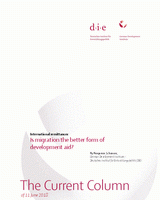International remittances
Is migration the better form of development aid?
Schraven, BenjaminThe Current Column (2018)
Bonn: German Development Institute / Deutsches Institut für Entwicklungspolitik (DIE), The Current Column of 11 June 2018
Bonn, 11 June 2018. Public discourse within Europe on migration is currently characterised primarily by issues of isolationism and repatriation. For instance, a fierce debate is taking place in Germany on Horst Seehofer’s proposal for new centres for asylum seekers, Italy’s new Interior Minister Matteo Salvini intends to deport illegal migrants from the country as quickly as possible and, even in the tranquil state of Slovenia, an anti-immigration party has won the parliamentary elections. At the same time, there are certainly voices contributing differentiated positions on displacement and migration, including a number of economists who are particularly keen to underscore the enormous development potential offered by the remittances sent by migrants to their families in developing countries and emerging economies. These economists consider these payments to be the most effective development intervention. At a time of growing controversy in the discussion on the benefits of development cooperation for tacking the causes of displacement, should we not make efforts to leverage this potential more effectively? To put it another way: are remittances the better form of development aid?
Looking at the figures, one might think so. According to the World Bank, migrants sent some USD 466 billion in remittances to countries in the global South in 2017. This is three times the amount of international development aid received by these countries. Indeed, though unknown, the actual volume of remittances is likely to be somewhat higher, as many migrants transfer money to their relatives by direct means, whether handing it over in person or via intermediaries, rather than using banks and money transfer operators such as Western Union.
At the same time, this is more than a numbers game. It is equally important to consider the purpose for which the recipients will ultimately use the money. The old cliché that people are mainly concerned with conspicuous consumption, that is, with purchasing expensive watches, mobile phones and other goods for the primary purpose of impressing those around them, is untenable in this case. Remittances are certainly used to pay for health care and education, and they are often reinvested too. This gives rise to positive economic effects that are felt beyond the group of recipients itself. It is not without good reason that the development cooperation community and a number of researchers investigating the topic of migration have discovered migrant remittances for themselves. The United Nations has even declared 16 June the International Day of Family Remittances.
However, it would be misguided to assume that remittances could essentially replace development aid and that migrants are the true or better aid workers. Despite all the positive effects, economists have a hard time identifying any significant correlation between remittances and national economic growth. As such, we must take a critical view of the purported role of remittances as the driving force for economic growth. And we should also be careful not to overestimate the impact of efforts, such as those in Mexico, to mobilise funds from migrants in order to channel them into local development projects in their home communities. Remittances are in the first instance private transfers and cannot simply replace the provision, funding and maintenance of public infrastructure, whether in health care, education, transport or any other sector. Even at the micro level, the effects of remittances are not all positive. For instance, they can increase inequality in migrants’ countries of origin between households that receive payments and those that do not.
Additionally, adopting too much of a functionalist approach to remittances masks the fact that this money is often earned under extremely difficult conditions. Unfortunately, harsh living and working conditions are part and parcel of everyday life for many migrants. Perhaps the Global Compact on Migration, currently being negotiated, can provide significant impetus for bringing about long-term change here. The Compact is a (non-binding) agreement designed to establish rules for “safe, orderly and regular” international migration in line with the UN’s Sustainable Development Goals. Civil society organisations are particularly committed in this context to improving the protection afforded to migrants.
It is clear that, in addition to (further) boosting remittances, improving the living and working conditions of migrants could also consolidate other positive effects of migration. These include the transfer of knowledge and expertise acquired by migrants to their countries of origin and the facilitation by migrants of economic, social and political discourse between their host and home countries. For all the discussion about isolationism and repatriation, we should not lose sight of the fact that migration also contributes positively to development in these ways as well as through remittances.

